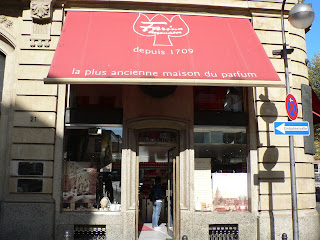Germany trips - Koln - train station & cologne
.jpg)
.jpg)
.jpg)
.jpg)
4711... it means nothing to me... but more age-advanced people may have heard about it in HK, seen its advertisement in HK, or even used it...
However, it's not the original cologne, the red one is the original one, since 1709 wor...
Eau de Cologne (French for "water of Cologne", Kölnisch Wasser in German) is a type of light Perfume that originated in Cologne, Germany and is defined by its typical concentration of about 2-5% essential oils.
Composition
In a base of dilute ethanol (70-90%), Eau de Cologne contains a mixture of citrus oils including oils of lemon, orange, tangerine, bergamot, lime, grapefruit and neroli. It can also contain oils of lavender, rosemary, thyme, petitgrain, and jasmine.
History
Eau de Cologne is a spirit-citrus perfume launched in Cologne in 1709 by Giovanni Maria Farina (1685-1766), an Italian perfumer from Santa Maria Maggiore Valle Vigezzo, Italy. When Farina composed the perfume, he said he wanted it to have the odor of an Italian spring morning after the rain.
Composition
In a base of dilute ethanol (70-90%), Eau de Cologne contains a mixture of citrus oils including oils of lemon, orange, tangerine, bergamot, lime, grapefruit and neroli. It can also contain oils of lavender, rosemary, thyme, petitgrain, and jasmine.
History
Eau de Cologne is a spirit-citrus perfume launched in Cologne in 1709 by Giovanni Maria Farina (1685-1766), an Italian perfumer from Santa Maria Maggiore Valle Vigezzo, Italy. When Farina composed the perfume, he said he wanted it to have the odor of an Italian spring morning after the rain.
The Original Eau de Cologne was used only as a perfume, and Napoleon was a particular enthusiast of the Farina Eau de Cologne.
Giovanni Maria Farina's formula has been produced in Cologne since 1709 by Farina gegenuber and to this day has remained a secret. His shop at Obenmarspforten opened in 1709 and is today the world's oldest fragrance company. Other Colognes have the name in common and smell different, such as the famous Cologne 4711, named after this location at the "Glockengasse No. 4711". In 1806, Jean Marie Joseph Farina, a grandgrandnephew of Giovanni maria Farina (1685-1766), opened the Paris perfumery business that developed into Roger & Gallet, who owns the rights to Eau de Cologne extra vielle in contrast to the Original Eau de Cologne from Cologne.
Eau de Cologne, or just "cologne", has now become a generic term. Ironically, however, the original Eau de Cologne from Cologne is not an Eau de cologne, but an Eau de toilette, because it contains more than 5% aromatic compounds.
Labels: Germany Trips

0 Comments:
Post a Comment
<< Home